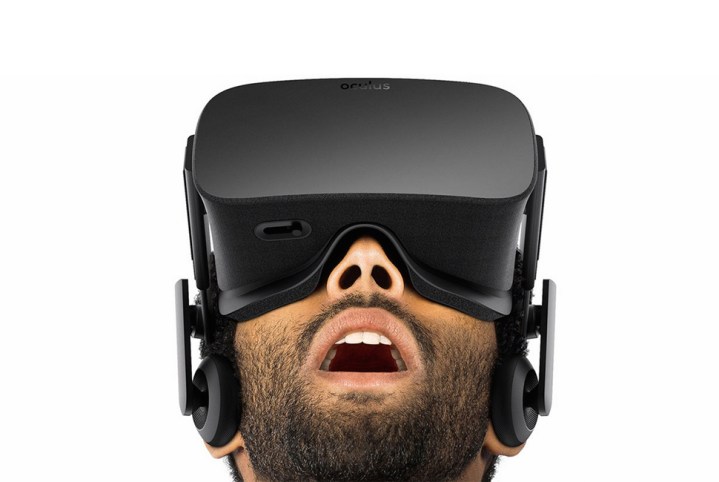
Updated January 6, 2016 by Brendan Hesse: Updated with Oculus pricing, availability, and hardware requirements information revealed at CES 2016.
Oculus Rift |
Gear VR |
|
| Optical Lens | 110 degrees or greater | 96° field of view |
| Display | 2160 x 1200 pixel, 90Hz built-in OLED displays | 2560 x 1440 pixel Super AMOLED |
| Refresh Rate | 90 Hz | 60 Hz |
| Required Hardware | PC with Windows 7 SP1 or newer, 8GB of RAM or more, Intel i5-4590 equivalent or greater, Nvidia GeForce GTX 970/AMD 290 equivalent or greater | Galaxy Note 5, Galaxy S6, S6 Edge, and S6 Edge+ |
| Sensor | Gyrocope, accelerometer, magnetometer, Constellation array | Accelerator, gyrometer, geomagnetic, proximity |
| Focal Adjustment | None | Focus adjustment wheel |
| Interpupillary Distance Coverage | Default distance set at 64 mm, adjustable range TBA | 54~70 mm |
| Physical UI | Xbox controller, Oculus Touch controllers | Touchpad, back button, volume key |
| Connection | HDMI 1.3 video output to headset•2x USB 3.0 ports for peripherals | MicroUSB connection to Galaxy Note 5, S6, S6 Edge, S6 Edge+ |
| Dimensions | TBA, 1.3 x 14.7 x 7 inches for Dk2 dev kit | 201.9 x 116.4 x 92.6 mm |
| Weight | <380 grams | 310 grams |
| Color variants | Black | Frost White |
| Price | $599 (Includes headset, Xbox One Controller, Sensor Array, and bundled software) | $99, plus cost of phone |
| Availability | Pre orders available, begin shipping on March 28, 2016 | Available Now |
| DT Review | Hands On | Review |
Design
While neither option is going to blow you away in terms of style, appearance-wise, Samsung has Oculus beat with its Gear VR headset. There’s no denying how trendy this thing looks, even if the whole concept of fashionable VR is completely foreign to us right now. At least on the exterior, it’s the perfect complement to Samsung’s mobile devices, which is an appreciated touch considering it works so closely in conjunction with the Galaxy Note 5 and the trio of Galaxy S6 handsets.
On the other end of the spectrum, the Oculus Rift’s appearance isn’t exactly subtle. Though the final design we see below has iterated significantly on the previous dev kit’s design and certainly bears a more pleasing aesthetic than the one before that, it’s still hard to ignore how bulky it looks, even if it does promise a weight under 380 grams.
The matte finish might serve better than the Gear VR at resisting scratches, but it doesn’t save the Oculus from the uncomfortable stares you’ll assuredly get while donning the display.
Winner: Gear VR
Performance
Performance-wise, the Oculus and Gear VR are two different beasts. The Oculus is a clearcut winner here, offering up two integrated OLED displays, bolstered by an accumulated 2160 x 1200 pixel crystal clear image and buttery smooth 90Hz refresh rate. While the Gear VR presents a fair challenge to the Rift in terms of resolution, as you can imagine, an Ultra HD image exhibited from a 6-inch smartphone will likely pale in comparison, and graphics performance is limited by smartphone hardware.
Winner: Oculus Rift
Software
The software catalogue, as you can imagine, is much more capable of delivering familiar content on the Rift. While Gear VR is host to some assuredly innovative indie offerings, games like House of Languages and Blind Swordsman aren’t exactly household names. No, the more well-known software rests in the hands of the Rift.
This one’s up to personal preference mostly, but I’m more interested in the prospect of the Rift to go back and play games like Half-Life 2 and Dying Light with an immersive new atmosphere as opposed to a few select glorified mobile games.
Winner: Oculus Rift
Price
The Rift is an expensive piece of hardware on its own, running a $599 price tag. But when you factor in the need for an extremely powerful PC, that price point suddenly skyrockets. The Gear VR, on the other hand, is affordable for anyone with one of the compatible Galaxy smartphones at $99. Sure, for under 100 bucks you aren’t guaranteed the same level of immersion as you’d expect with the Rift, but it’s a nifty, low-cost sample of the future.
And you don’t have to know the first thing about PC specs in order to use one.
Winner: Gear VR
Conclusion
The Oculus Rift and Gear VR both deliver on almost paradoxical fronts. While Oculus brings the power of PC gaming to a head-mounted virtual reality display, Gear VR serves as a convenient introductory point for anyone only casually interested in this emerging tech. Especially in reference to pricing, much of Oculus Rift’s features remain ambiguous.
Considering both peripherals bear some sense of innovation, although in antithetical ways, making a decision on which is objectively “better” isn’t really needed this time around. They’re both powered by the same company (Gear VR is designed in conjunction with Oculus) and are both sure to evoke their fair share of buzz by the time their respective release dates roll around.
I suppose in that sense, everybody wins.
Winner: Tie




